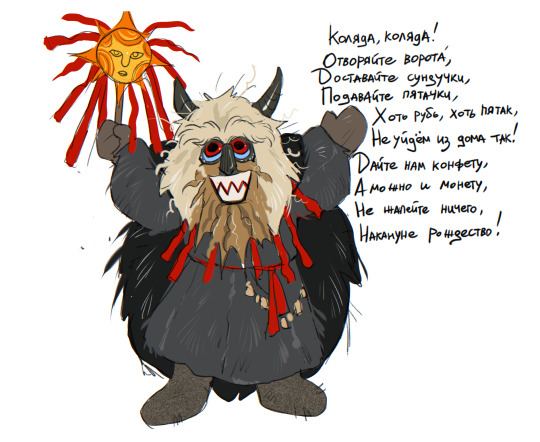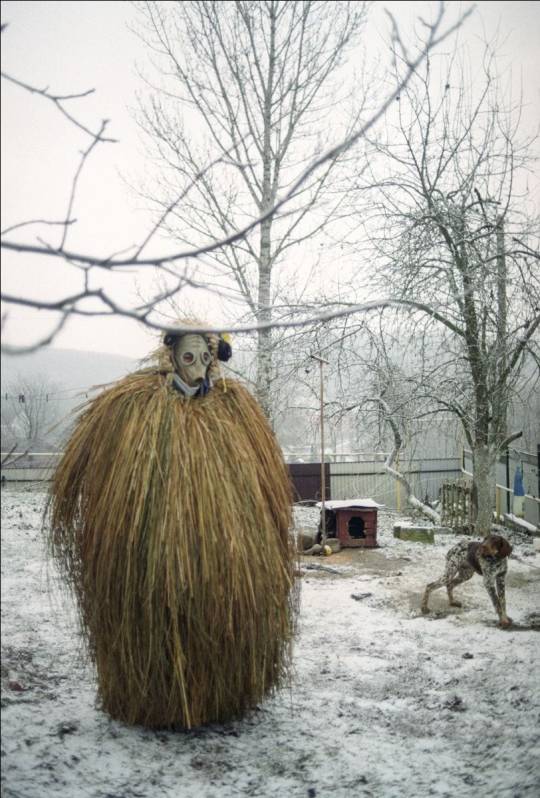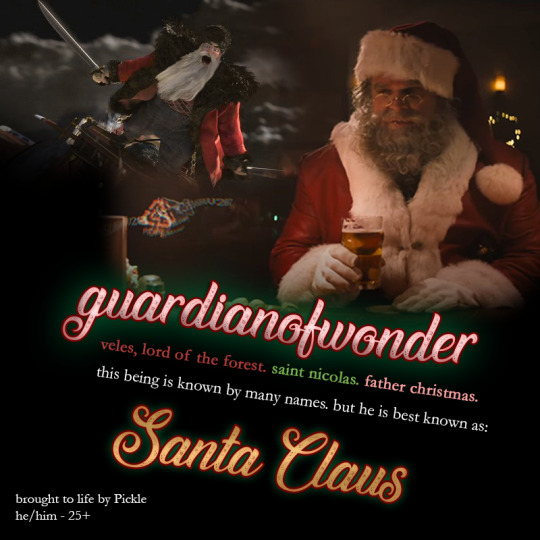#slavic holidays
Text

Ivan: Cowboy, I'm not going to celebrate your satanic holiday, damn it, you're dressing up as some demons and you think I'll treat this as something normal?
Kolyadki
Ivan as a child:

Ivan: Kolyada, kolyada! Open the gates and take out the chests, give us coins, even a ruble (1), even a nickel (5), we will not leave you just like that. Give us a piece of candy, or maybe a coin, don't be a jerk, Christmas Eve is coming soon!

Ivan: On New Year's Eve I wish you an aspen coffin, a stake and a grave, and a sick mare (curse)
_______________________________
Maslenitsa
(Maslenitsa is a pagan holiday still celebrated in Russia. Meaning: people see off winter by burning an effigy symbolizing the Goddess of Winter Morena. People bake crepes. Crepes, at least in Russia, appeared as a funeral food, which is consumed during funerals. At the moment, crepes are a common dish, but crepes are still an important dish for Maslenitsa):

Ivan: Die, Morana (Goddess of Death/Rebirth/Winter.), die, die, die, yes yes yes, die
Ivan Kupala (Kupala Night):

There is very little information in the English wikipedia
The holiday combines two elements: pagan and Christian. Previously, this holiday existed independently, but after the baptism of Russia, the holiday acquired a Christian meaning and elements. The main feature of Kupala night is the cleansing bonfires. Around the fire, people danced, danced, sang Kupala songs, jumped over it: whoever is more successful and jumps higher, he will be happier. Girls jump through the fire "to purify themselves and protect themselves from dumbness, spoilage, conspiracies," and so that "mermaids do not attack and do not come for a year." Evil spirits come to life on this holiday, people performed certain rituals to scare away witches, mermaids and other evil spirits. Also, people wove wreaths of certain flowers, which also carry a magical meaning, women let such wreaths on the water to tell themselves an early wedding or a long life. Also on this holiday it is customary to look for a fern flower, which according to Slavic beliefs, the fern blooms only for a moment, on the night before Ivan Kupala (on June 24 [July 7 in Russia]); it is very difficult to pluck a flower, especially since the evil spirit prevents this in every possible way and intimidates a person, in some cases depriving him of reason, speech, memory. Picking the flower of a fern and keeping it with him acquires unusual possibilities. Man becomes visionary, can understand the language of animals, see all the treasures.
717 notes
·
View notes
Text
My Slavic Polytheist Calendar
Every Slavic Polytheist will have their own calendar constructed based on where they are from, what deities they worship, and any number of other personal preferences they may have. As such, beginners will often find themselves incredibly confused on where to start, which either leads to decision paralysis or trying to shoehorn Slavic traditions into the Wiccan wheel of the year, which doesn't usually go well because of the very different nature of these two practices, no matter how syncretic one of them tries to be.
With this in mind, I've decided to share the calendar I use in my practice on my blog and my TikTok, though this will have more detail than the video. It's important to note, though, that my calendar takes my needs and preferences into account above all else. This means that it is primarily influenced by Carpatho-Rusyn Orthodox traditions, the ADF's calendar, common East Slavic celebrations, and a combination of Lemko and American traditions.
❆ Winter ❆
January 7 - Epiphany
It's Christmas, except your dad might go outside and threaten any trees that didn't bear fruit last harvest with an axe and you might summon a demon to see what your future husband looks like. You will also stack bread in a mountain at the end of your dinner table in hopes of bringing prosperity into the upcoming year.
January 8 - Fašengy Begins
To be totally honest, the dating on this holiday is confusing as all get out. It's essentially a Slavic Mardi Gras but, depending who you ask, it can also simply be the season where a lot of people in your community get married and/or start having children. I mark this date because that's when the marrying and child rearing begins, but Fašengy festivities in Rusyn communities typically don't start until the day after Epiphany and ends on Ash Wednesday, when Lent starts. During these festivities, you would eat, drink, be merry, and try to get married.
January 13 - Malanka
New Year's Eve celebrations. Prepare for a small army of children to wish you well in the morning. If you're a laborer, enjoy the day off but also worry about your contract being renewed.
January 14 - New Year's Day
Continuation of well wishes and repeating your wishes from Christmas in hopes that they come true in the upcoming year.
February 1 - Winter-Cross Quarter on the ADF's Calendar
Much like New Years, its time to begin establishing your wishes and vision for the upcoming year while shedding the old year.
February 11 - Veles' Day or the Festival of Veles
Sometimes celebrated on the 24th of February, Veles is venerated on the same date(s) as Saint Blaise, an Orthodox and Catholic saint that Veles has become syncretized with because of their shared patronage of flocks and herds. In neopolytheist communities, it is common for Veles to be offered milk and ritual fights will be organized. It is taboo to eat veal on this holiday, as Veles is being asked for protection of herds, including cattle.
❀ Spring ❀
March 11 - Maslenitsa Begins
Maslenitsa aligns with the last week of Fašengy as the last week before Lent. In some cases, this week is treated as the final goodbye to winter, in others, that doesn't happen until later on in the year. During Maslenitsa, it's customary to make blini, dance, sing, and generally indulge in any distractions of your choosing before the more reflective season of Lent begins. Each day of Maslenitsa is dedicated to different activities, family bonding, snowball fights, sleigh rides, and more
March 17 - Maslenitsa and Fašengy End
Lent has begun
March 21 - Komeoditsa & the Spring Equinox
Are you a fan of bears? Are you a fan of Spring? This is the holiday for you. In some cases this day is celebrated during Maslenitsa depending on when the week occurs. I personally choose to keep it more aligned with the Spring Equinox because of the importance of bears in my practice, so I will celebrate it differently from what is traditional. It is also an ADF holiday that centers perserverance.
March 28 - Passion Week Begins
A celebration of Jesus' triumph over Death. Fasting is strict and each day has its own theme, which is usually chanted about at the beginning of each day. Date of this holiday varies yearly.
May 1 - Spring Cross-Quarter
An ADF holiday that centers around fertility and honoring the budding nature around us.
May 1 - Dziady Begins
One of two, Dziady translates to "forefathers eve", it is a night in which the ancestors are venerated, celebrated, and communed with. Similar to Samhain or All Souls Eve.
May 2 - Dziady Ends
May 2 - Day of Young Shoots
A holiday in which young pine shoots are candied. There's not a wealth of easily accessible information on this holiday.
May 4 - Passion Week Ends
Fasting and restriction have occurred. If you're a witch, you have conducted a pilgrimage.
May 5 - Easter
Jesus is back baby. Here's some chocolate. Just kidding, this is a Rusyn household. You will be recieving horseradish, butter, sausage, pascha, salt, ham, pysanky, cheese, bacon, and a candle because we can eat meat and dairy again.
May 6 - Saint George's Day
Today's all about your livestock. Be happy they're here and do what you can to protect them.
May 14 - Radonitsa
Honor your dead, go visit the cemetery, and keep it clean.
𖤓 Summer 𖤓
May 28 - Green Week Begins
We're honoring the dead again, but this time they're in the trees.
May 30 - Zmeynik
Hey it's warm enough that the snakes are back! Be nice to them!
June 4 - Green Week Ends, Semik
Get the rusalki back into the lakes lest they start drowning our men. We do this by having a nice meal.
June 19 - Mokridy
Mokosh please let it rain. Please.
June 20 - Perun's Day
PERUN PLEASE LET IT RAIN
June 21 - Sobitka (Summer Solstice)
Fire! There is fire! Jump over it or be alone forever. Also there's a plant you can look for to see if you can talk to animals. The witches are gathering again and you know that one rich guy everyone hates? Set his farm on fire and thank the Zbeeynicks. For the ADF calendar, this day centers awakening and moderation.
June 24 - Saint John's Day
Sometimes celebrated on June 22, today's the day to gather your herbs and get them blessed so you can use them for the rest of the year!
August 1 - Summer Cross-Quarter
An ADF holiday centering courage and preparing for the harvest season
August 15 - Our Lady of the Herbs
All the plants are blessed. Thank you Mother Mary.
☾ Autumn ☽
August 19 - Apple Feast of the Savior
We're harvesting apples. Autumn is starting and you will only eat apples.
September 23 - Dozynki & Autumn Equinox
Hell yeah harvest time! Appreciate your laborers, give them a feast and bless their bounties. This is another ADF harvest holiday that centers Integrity.
October 28 - Festival of Mokosh
There isn't a lot of historic information on this holiday, though its generally associated with the feast of Saint Paraskeva. Eat, drink, be merry, and embroider.
October 31 - Dziady Begins
The forefathers are back.
November 1 - Dziady Ends & Autumn Cross Quarter
The forefathers have been honored. This ADF holiday centers honoring the dead and pursuing wisdom.
November 29 - Andrzejki
Saint Andrew's Day! Fuck the nobility that subjugates you, harvest your crops and have a good time. Ladies, this is another opportunity to find out who your future husband is.
❆ Winter ❆
December 20 - Szczodre Gody Begins
Christmas. But not. Lots of feasting, merriment, and decorating of trees.
December 21 - Koliada, the Winter Solstice
Szczodre Gody continues, but it's officially the longest night of the year. The ADF calendar centers Hospitality on this date.
December 25 - Szczodre Gody Ends
Do divination until Epiphany.
10 notes
·
View notes
Text
One of the most magic nights in the year. Kupała night

#kupała night#noc kupały#slavic#fire#flower crown#slavic holidays#witch stuff#witch community#witchy
13 notes
·
View notes
Text

Morozko from the 1924 russian movie "Morozko" by Yuri Zhelyabuzhskiy.
Morozko (Grandfather Frost) is a spirit of frost or sometimes a wizard of winter. Since the 19th century this character has changed, and now he is a symbol of the New Year holiday. Morozko is similar to Santa Claus in his modern role in russian culture.
Honestly, I made this post only to promote the movie. You must see it, it's good. Morozko of 1924 is a silent movie, you can just read the tale to understand what is happening on the screen. The movie is basically a horror (but not really scary, not in modern sense at least), and the plot of the movie is closer to the fairy tale than the plot of the 1964 version.
Pro:
it's a movie adaptation of the fairy tale
it's a horror
Morozko!
actually interesting to watch
it's just 35 minutes long
authentical folk costumes from a century ago
wedding (the wedding song is a banger!)
There are no cons. Just watch it! :)
#movie#video#morozko#морозко#russian#slavic#russian movie#russian tales#русские сказки#yuri zhelyabuzhskiy#юрий желябужский#christmas movies#holiday#christmas#new year#silent film#silent movies#black and white film#black nd white movie#russian movies#russian films#horror#horror movies#horror films#scary movies#old movies#old films
349 notes
·
View notes
Text

Hoppas ni får en glad påsk!
#wiki#lucy#lesbian#bunny suit#they're wearing bunny ears and bunny suit for easter#also yeah it's salem's ears#art#my art#oc#what can i say the girls are having fun#i love bunny suits#they are very cool#hi did you know#that the reason why we have an easter bunny#is because it is a symbol of fertility and sex in pagan religions#and did you know christians took what was native to european people and then made it all sexless and about jesus!#haha!#im not pagan but all im saying is in the spirit of the og meaning of the holiday put on a bunny suit and just look hot over the weekend#also very traditional for slavic pagans is to clean your room to get the evil of the world out of your dusty corners and such#very cool i will do that tomorrow#and painting eggs#that's fun too
420 notes
·
View notes
Text

Vasylyna Vrublevska – Malanka, Ukraine
#vasylyna vrublevska#malanka#ukraine#paganism#eastern slavic culture#mаланка#shchedryi vechir#Ukrainian folk holiday
135 notes
·
View notes
Text
youtube
Winter in Moscow ❄️❄️❄️
#russia#russian aesthetic#slavic girls#winter#people#youtube#russians#Moscow#mood#snow#walk#livestream#holidays
31 notes
·
View notes
Text
Life in China #11
The downside of short holidays and festivals in China (Qingming, Labour Day etc.) is that you usually need to make up for them, so since I got Thursday and Friday off, I still had class on Sunday.
#slavic roots western mind#studyblr#college#college life#aesthetic#study motivation#student life#student#study blog#travel blog#study in china#china#asia#life in china#qingming#holidays#holiday#chinese#chinese holidays#chinese festival#festival
11 notes
·
View notes
Text

#aesthetic#feminine#divine feminine#graveyard#catholic#christian aesthetic#gothic#winter aesthetic#winter#russian winter#slavic winter#coquimbo#coquette#soft girl#aphrodite#witch#holiday
106 notes
·
View notes
Text


Kupala Night: A Vibrant Slavic Holiday and Its Magical Rituals
BY LENA LENARD
upala Night begins with lighting the “holy fires” in forest clearings as well as on the banks of rivers and lakes. Participants strike fire from ash, birch, or oakwood. In sacred places, they drive birch pegs into the ground and place ash hubs on them—that is, wheels with spokes wrapped in tarred straw. They spin the wheels so fast that the friction causes them to burn. They roll the burning wheels to nearby piles of wood and straw—symbols of home and hearth—and flames burst into the sky, sparking and roaring, symbolizing a new, clean home and hearth. At the same time, there’s singing and dancing. Women collect magical herbs and flowers. They weave wreaths and gird themselves with wormwood.
It’s a night of celebration and erotic awakening, with all-night revelries among the smoke of bonfires and the intoxicating smells of a summer night outdoors. In the past, marriages were arranged by the head or the elders of the family and matchmakers… but for the young women who had not yet been engaged and wanted to avoid the usual form of mating, here, among the flame and flowers, was a chance to win a loved one. A boy might even “kidnap” a dancing girl from around the fire and try to woo her.
CONTINUE READING HERE
25 notes
·
View notes
Text
ITS PUSCHANYA BITCHESSS
What is Puschanya?
More commonly called Maslenitsa, Puschanya is an East Slavic holiday that takes place on the week before the Great Lent (for the year of 2024 this is March 11 through March 17). It’s quite similar to Mardi Gras, in which it’s a week of people feasting and hosting a bunch of different events, which generally culimate with a burning of an effigy of Maslenitsa, similar to Marzanna drownings in Polish traditions.
How Can I Celebrate Puschanya?
❈ building a small effigy of the goddess of winter and destroying it
❈ making pierogi
❈ making blini (similar to crepes)
❈ visiting family and friends, sharing meals, and giving gifts on “Forgiveness Sunday” (March 17) and throughout the week
❈ spend time doing outdoor activities, like hiking, snowball fights, etc.
Although it’s primarily a Christian holiday at this point, there’s a great deal of suggestion that Maslenitsa predates Christianity; evidence suggests that the tradition dates to the 2nd century CE. The holiday maintains its’ pre-Christian roots quite obviously with the burning of the effigy and petitions for the onset of spring. It’s a fascinating example of how folk religion can develop through the merging of two traditions.
art by Valeriya Marakova

2 notes
·
View notes
Text
TRAVEL BACK A CENTURY OR so, to a chilly winter night. Christmas has come and gone, and New Year’s Eve is on the horizon when a group of carolers approach your door. They’re dressed as figures from the Nativity. Elated, you welcome them. Then you notice a terrifying stranger among them: a tall creature with musky-smelling hair, silver bull horns, and a snapping jaw pierced with nails. He dances and jumps to the music, sometimes pouncing on children.
Meet Turoń, a symbol of virility. Polish Academy of Sciences folklorist Ewa Masłowska says the figure’s name derives from tur, the Polish word for aurochs, an ancient bovine that roamed much of Eurasia but was hunted to extinction by the 17th century. Turoń was one of the traditional characters portrayed by mummers who wandered and danced through the streets of Poland from Christmas through Lent. Unlike other European winter creatures, such as Père Fouettard and Krampus, Turoń does not dole out punishment. Instead, says Masłowska, this hirsute representative of ideal manhood brings blessings of fertility, including a good harvest for the year ahead.
Performing as Turoń descended from a millennia-old pre-Christian Polish tradition, when men dressed as aurochs and danced in rituals intended to bring fertility to their communities and farmland. The modern Turoń entered each home to chase people, particularly children, and dance frantically to the music. He then collapsed into a lifeless heap on the floor, only to be “reborn” when the carolers or hosts provided him with a small sip of vodka. After drinking it, he sprang to life again. According to Masłowska’s research, this ritual of life, death, and rebirth echoes another ancient pagan tradition in Poland: symbolizing the lunar cycle of waxing and waning through different animals, which in turn also represent ritual rites of passage for humans. In the tradition, the impressive horns of the aurochs are a symbol of the crescent moon.
The tur—and, by extension, Turoń—is primarily associated with fertility, strength, and masculinity. Even today in Poland, the phrase silny jak tur, or strong as an aurochs, conveys power and sexual prowess in a man.
However, it turns out that even the virile Turoń needs protection. Turoń behaves aggressively, and the costumes are particularly fearsome, the mummer’s face completely hidden, to fool evil spirits that might also have been out and about on the cold winter night.
“The mask was to protect against the devil, against evil. If they are in the mask, it means that they are strangers,” Masłowska says. “The evil is also a stranger, so the evil will not disturb [Turoń, thinking it is one of their own].”
Turoń’s terrifying appearance, and tendency to chase children, allows the figure essentially to blend in with malevolent creatures so that they leave him alone, letting him stealthily deliver blessings to the community.
The tradition of Turoń coming to your door around Christmas more or less died out in the 20th century, though mummers dressed as aurochs were sometimes spotted in the days leading up to Ash Wednesday and other times of year.
However, much like the revival of Krampus, now a global phenomenon, the Germanic Frau Perchta, and the shaggy kukeri of Bulgaria, Turoń is making a bit of a comeback. While the blessing bull figure is likely enjoying more attention as part of a pop culture trend celebrating the darker characters of winter holidays, there’s something else behind renewed interest in the tradition. Some practitioners of Rodnovery, a modern interpretation of pre-Christian Slavic beliefs, are reviving the ancient pagan fertility ritual of stado, which involved men dressed as aurochs, and bringing the dancing bull back to Polish streets.
So if a tall creature resembling a bull shows up at your door, don’t dismiss him out of hand. Just have the vodka ready.
8 notes
·
View notes
Text

"You better watch out, you better not cry, better not pout, I'm telling you why—Santa Claus is coming to town." — Haven Gillespie
𝐠𝐮𝐚𝐫𝐝𝐢𝐚𝐧𝐨𝐟𝐰𝐨𝐧𝐝𝐞𝐫, an independent 𝐒𝐀𝐍𝐓𝐀 𝐂𝐋𝐀𝐔𝐒 written by 𝐏𝐈𝐂𝐊𝐋𝐄.
2 notes
·
View notes
Text

Vasylyna Vrublevska – Malanka, Ukraine
#vasylyna vrublevska#malanka#ukraine#paganism#eastern slavic culture#mаланка#shchedryi vechir#Ukrainian folk holiday#january 13th
37 notes
·
View notes
Text

i now pronounce you man and... thing! after 4 years, these two are officially [& illegally] married and ready to engage in just as many illegal activities as before, but as a Married Couple this time. it's a bit empty in there, so my mutuals/followers/everyone are all free & encouraged to draw themselves & their f/os in there as wedding guests, t.f2 or not [that's why there's so much blank space. please do that i am asking so niceys]. anyways, don't worry - the rest of the team has at least one person running around with an extinguisher at all times, so everything won't burn down after like 15 minutes
friends & mutuals that agreed to be tagged: @clovergardenselfshipping , @3lectro-heart
#i wasnt sure how much blank space will be a good amount so like. feel free to add more if needed idm#also its kupala night and its the old slavic holiday of love. so#literally perfect night to get married if you ask me#ITS LITERALLY A NIGHT CELEBRATING LOVE LIKE CMON#i was gonna color this originally but ended up playing portal all evening and ended up just like. vaguely cleaning up the sketch instead#so yeah. i actually started lining this but then realized if i put Too much effort into it people might get discouraged#so like Fuck It literally draw a quick sketch and i will be the happiest man ever of all time#ok im done rambling once again asking so niceys to draw sth ok thank u bye#🔥#art tag
5 notes
·
View notes
Text
My Christmas in China
Merry (late) Christmas! I didn't really celebrate Christmas this year, I actually almost forgot all about it until a few days ago😅
We had class as per usual on Christmas day, but during the last hour or so we watched the Karate Kid and ate biscuits and mini-fruit jelly things so it turned out quite nice. My friend also sent over a huge box of chocolates which arrived right after class, so I got a little Christmas miracle after all 💖
How are your holidays going?
#studyblr#college#aesthetic#christmas#chinese studyblr#college life#student life#student#study motivation#travel blog#study blog#slavic roots western mind#mandarin langblr#mandarin#langblr#chinese language#Christmas in china#christmas 2023#holidays#holidays in china
8 notes
·
View notes